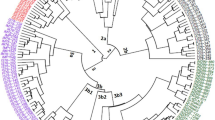Abstract
Restriction site amplified polymorphism (RSAP) was used, for the first time, to analyze the genetic structure and diversity of four, mainly cultivated, varieties of the brown alga, Saccharina japonica. Eighty-eight samples from varieties “ Rongfu ”, “ Fujian ”, “ Ailunwan ” and “ Shengchanzhong ” were used for the genetic analyses. One hundred and ninety-eight bands were obtained using eight combinations of primers. One hundred and ninety-one (96.46%) were polymorphic bands. Nei’s genetic diversity was 0.360, and the coefficient of genetic differentiation was 0.357. No inbreeding-type recession was found in the four brown alga varieties and the results of the “ Ailunwan ” variety using samples from 2 years showed that the variety was becoming less diverse during the selection inherent in the breeding program. Genetic diversity and cluster analyses results were consistent with these genetic relationships. The results show the RSAP method is suitable for genetic analysis. Continuous inbreeding and selection could reduce the genetic diversity effectively; therefore periodical supervision is required.
Similar content being viewed by others
References
Bassam B J, Caetano-Anolles G, Gresshoff P M. 1991. Fast and sensitive silver staining of DNA in polyacrylamide gels. Analytic. Biochem., 196: 80–83.
Du X H, Wang D Y, Gong Z H. 2006. Development and refinement of a new marker technique-restriction site amplified polymorphism (RSAP). J. Northwest A & F University, 34(9): 45–49. (in Chinese with English abstract)
Du X H, Wang D Y, Gong Z H. 2007. Estimation and comparison of genetic distances among elite inbred lines in hot pepper (Capsicum annuum L.) by RSAP and SSR. J. Northwest A & F University, 7(7): 97–102. (in Chinese with English abstract)
Excoffier L, Laval G, Schneider S. 2005. Arlequin ver. 3.0: an integrated software package for population genetics data analysis. Evol. Bioinform. Online, 1: 47–50.
Li H J. 1996. Some Questions Regarding Cultivation of Laminaria japonica in China. Ocean Press, Beijing. (in Chinese)
Lichtenstein C P, Draper J. 1985. Genetic engineering of plants. In: Glover D M ed. DNA Cloning: A Practical Approach, Vol. II, IRL Press, Oxford, UK. p.67–119.
Liu F L, Wang X L, Yao J T. 2010. Development of expressed sequence tag-derived microsatellite markers for Saccharina (Laminaria) japonica. J. Appl. Phycol., 22: 109–111.
Miller M P. 1997. Tools for population genetic analysis (TFPGA) 1.3: A window program for the analysis of allozyme and molecular population genetic data. Computer software distributed by author.
Qiao L X, Guo B T, Wang J S et al. 2012. Genetic variation in 14 Porphyra lines using restriction site amplified polymorphism (RSAP). J. Appl. Phycol., 24: 61–67.
Qiao L X, Weng M L, Kong F N et al. 2007. The Application of RSAP marker technique in diversity detection and germplasms identification of Porphyra. J. Ocean University of China, 37(6): 951–956. (in Chinese with English abstract)
Shi Y Y, Yang G P, Liao M J. 2008. Parentage analysis of Dongfang No.2, a hybrid of a female gametophyte clone of Laminaria japonica (Laminariales, Phaeophyta) and a male clone of L. longissima. J. Ocean University of China, 7(2): 193–198.
Sun X Y, Luo D, Zhao C, Li W, Liu T. 2011. DNA extraction and PCR analysis of five kinds of large seaweed under different preservation conditions. Mol. Plant Breeding, 9: 1 680–1 691. (in Chinese with English abstract)
Tokida J, Nakamura Y, Druehl L D. 1980. Typification of species of Laminaria (Phaeophyta, Laminariales) described by Miyabe, and taxonomic notes on the genus in Japan. Phycologia, 19(4): 317–328.
Tseng C K. 2001. Algal biotechnology industries and research activities in China. J. Appl. Phycol., 13: 375–380.
Yeh F C, Yang R C, Boyle T. 1999. POPGENE, version 1.31. Microsoft Window-Based Freeware for Population Genetic Analysis. Quick User-Guide (Francis Yeh, University of Alberta, Canada). www.ualberta.ca/-fyeh.
Zemke-White W L, Ohno M. 1999. World seaweed utilization: an end-of-century summary. J. Appl. Phycol, 11: 369–376.
Zhang M K, Zhang L G, Gong Z H et al. 2009a. Construction and analysis of a molecular genetic map of Chinese cabbage. Molecular Plant Breeding, 7(1): 82–88. (in Chinese with English abstract)
Zhang M K, Zhang L G, Gong Z H et al. 2009b. New primers design and reaction system optimization of restriction site amplified polymorphism (RSAP) marker technique. J. Northwest A & F University, 37(2): 148–154. (in Chinese with English abstract)
Zhang Q S, Liu S P, Qu S C et al. 2001. Studies on rearing new variety of kelp “901”. Transactions of Oceanology and Limnology, 2: 46–53. (in Chinese with English abstract)
Zhou Z G, Shi X Z, Hu Y J et al. 2003. Genetic relationship among brown seaweed Laminaria longissima and various cultivars of L. japonica in China revealed by isozyme and RAPD markers. J. Fishery Sciences of China, 10(6): 474–480. (in Chinese with English abstract)
Author information
Authors and Affiliations
Corresponding author
Additional information
Supported by the National Special Research Fund for Non-Profit Sector (No. 200805075), the Shandong Foundation for Development of Science and Technology, China (No. 2007GG10005018), the Genetically Modified Organism Technology Major Project (No. 2009ZX08009-100B), the National High Technology Research and Development Program of China (863 Program) (Nos. 2010AA10A401, 2012AA10A406), and the National Agricultural Transformation (No. 2010GB23600666)
Rights and permissions
About this article
Cite this article
Zhao, C., Liu, C., Li, W. et al. Application of restriction site amplified polymorphism (RSAP) to genetic diversity in Saccharina japonica . Chin. J. Ocean. Limnol. 31, 830–834 (2013). https://doi.org/10.1007/s00343-013-2122-2
Received:
Accepted:
Published:
Issue Date:
DOI: https://doi.org/10.1007/s00343-013-2122-2




